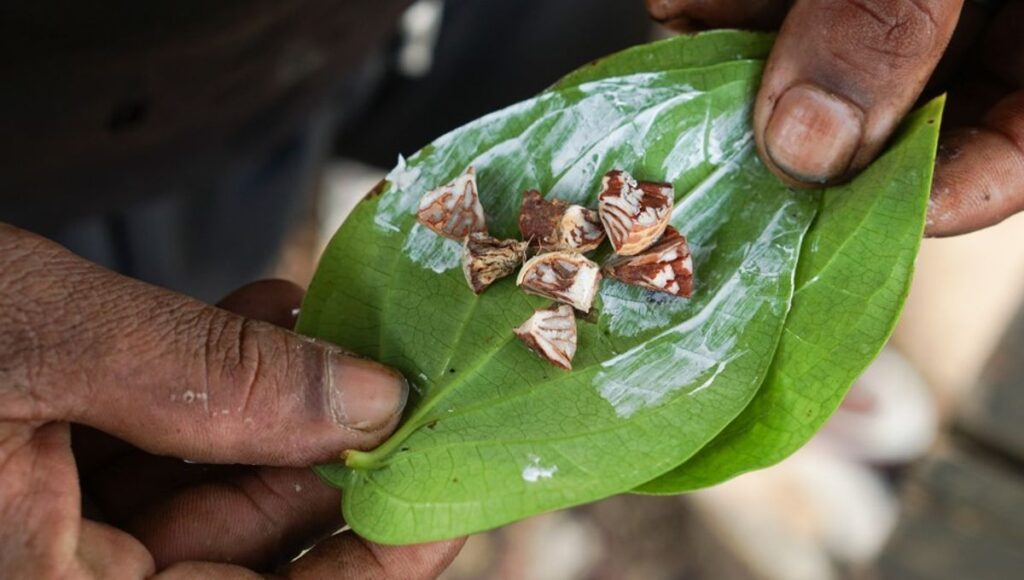
Bronze-Age communities in Thailand were using psychoactive betel nuts to enhance alertness, relax their bodies and minds, and generate a sense of euphoria as far back as 4,000 years ago. This discovery, highlighted in a recent study, sheds light on the cultural and ritualistic significance of betel nuts in ancient Southeast Asian societies. Although currently demonized and banned in urban areas of Thailand, the natural stimulant continues to be consumed both ritually and recreationally in rural regions, indicating its enduring cultural legacy.
The betel nut, belonging to the palm family, thrives throughout Southeast Asia and the Pacific islands. Traditionally, the nut is chewed with leaves and limestone paste, producing a distinctive red saliva that requires frequent spitting. Archaeological sites across the region have yielded remnants of betel nutshells, and some skeletons have been found with brown or black stained teeth, indicative of long-term chewing. However, new research reveals that even those without stained teeth may have engaged in this practice.
Uncovering Ancient Practices
At the Bronze Age site of Nong Ratchawat in central Thailand, researchers have uncovered the oldest known evidence of betel nut consumption. By examining dental plaques from six skeletons, none of which displayed the typical signs of betel nut chewing, the study provides new insights into ancient practices. In the dental calculus of one female individual who lived approximately 4,000 years ago, traces of arecoline and arecaidine were discovered. These compounds are the primary psychoactive components in betel nuts.
Based on ethnographic interviews with contemporary users, the study suggests that ancient Southeast Asians held a variety of traditional beliefs regarding betel nut chewing. The authors note that some communities attributed ceremonial use of the nut to healing metal-related injuries and wounds from animal attacks. Furthermore, evidence suggests that betel nuts played a role in agricultural rituals.
Cultural and Ritual Significance
Study author Piyawit Moonkham explained to IFLScience that “people used betel nuts as offerings for the spirits, especially during the harvest season, in order to ask the gods for help with rice cultivation and the paddy fields.” This highlights the nut’s integral role in the spiritual and agricultural life of ancient communities.
“Understanding the cultural context of traditional plant use is a larger theme we want to amplify – psychoactive, medicinal, and ceremonial plants are often dismissed as drugs, but they represent millennia of cultural knowledge, spiritual practice, and community identity,” Moonkham stated.
Moonkham further remarked on the psychoactive effects of the nut, noting, “I tried it myself, and it stimulates some senses while soothing the whole body… I think it’s the same kind of reaction that we have when we drink coffee or smoke tobacco.”
Modern Implications and Historical Context
Despite its historical significance, the consumption of betel nuts in public spaces has been banned in Thailand since the early 1940s due to its negative impact on oral health. This prohibition has led to a decline in traditional practices and beliefs in many of the country’s urban areas. “Since the Thai government prohibited betel nut chewing, most research has shifted to focusing on its negative effects,” Moonkham noted. “But before this, the plant had a lot of social, cultural and religious significance.”
The study, published in the journal Frontiers in Environmental Archaeology, offers a comprehensive view of human-plant interactions from the past to the present. It encourages a reevaluation of our relationship with psychoactive plants, emphasizing their cultural and historical importance.
“So the information [in the new study] can tell us about human-plant interactions from the past to the present and help us to change or re-think our relationship with psychoactive plants in particular,” Moonkham concluded.
This research not only enriches our understanding of ancient Southeast Asian cultures but also invites a broader discussion on the cultural significance of plants often dismissed as mere stimulants or drugs. As we continue to explore the past, such studies remind us of the complex interplay between human societies and the natural world.







